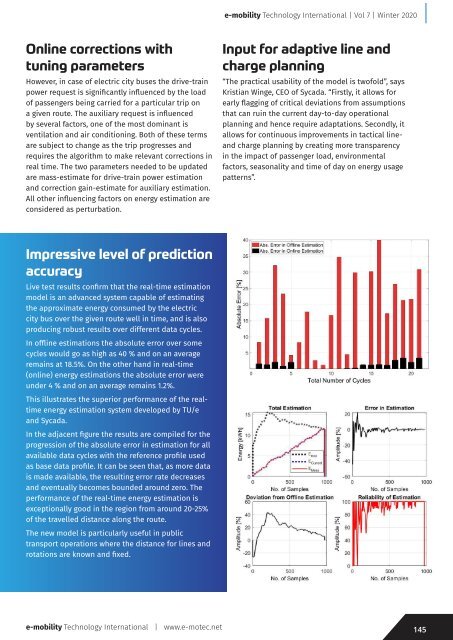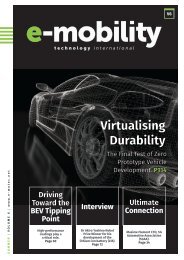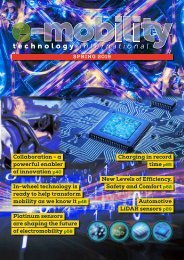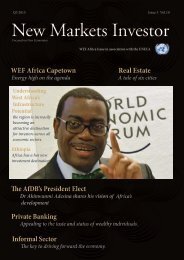E-mobility Technology Winter 2020
Electric vehicle technology news: Maintaining the flow of information for the e-mobility technology sector
Electric vehicle technology news: Maintaining the flow of information for the e-mobility technology sector
You also want an ePaper? Increase the reach of your titles
YUMPU automatically turns print PDFs into web optimized ePapers that Google loves.
e-<strong>mobility</strong> <strong>Technology</strong> International | Vol 7 | <strong>Winter</strong> <strong>2020</strong><br />
Online corrections with<br />
tuning parameters<br />
However, in case of electric city buses the drive-train<br />
power request is significantly influenced by the load<br />
of passengers being carried for a particular trip on<br />
a given route. The auxiliary request is influenced<br />
by several factors, one of the most dominant is<br />
ventilation and air conditioning. Both of these terms<br />
are subject to change as the trip progresses and<br />
requires the algorithm to make relevant corrections in<br />
real time. The two parameters needed to be updated<br />
are mass-estimate for drive-train power estimation<br />
and correction gain-estimate for auxiliary estimation.<br />
All other influencing factors on energy estimation are<br />
considered as perturbation.<br />
Input for adaptive line and<br />
charge planning<br />
“The practical usability of the model is twofold”, says<br />
Kristian Winge, CEO of Sycada. “Firstly, it allows for<br />
early flagging of critical deviations from assumptions<br />
that can ruin the current day-to-day operational<br />
planning and hence require adaptations. Secondly, it<br />
allows for continuous improvements in tactical lineand<br />
charge planning by creating more transparency<br />
in the impact of passenger load, environmental<br />
factors, seasonality and time of day on energy usage<br />
patterns”.<br />
Impressive level of prediction<br />
accuracy<br />
Live test results confirm that the real-time estimation<br />
model is an advanced system capable of estimating<br />
the approximate energy consumed by the electric<br />
city bus over the given route well in time, and is also<br />
producing robust results over different data cycles.<br />
In offline estimations the absolute error over some<br />
cycles would go as high as 40 % and on an average<br />
remains at 18.5%. On the other hand in real-time<br />
(online) energy estimations the absolute error were<br />
under 4 % and on an average remains 1.2%.<br />
This illustrates the superior performance of the realtime<br />
energy estimation system developed by TU/e<br />
and Sycada.<br />
In the adjacent figure the results are compiled for the<br />
progression of the absolute error in estimation for all<br />
available data cycles with the reference profile used<br />
as base data profile. It can be seen that, as more data<br />
is made available, the resulting error rate decreases<br />
and eventually becomes bounded around zero. The<br />
performance of the real-time energy estimation is<br />
exceptionally good in the region from around 20-25%<br />
of the travelled distance along the route.<br />
The new model is particularly useful in public<br />
transport operations where the distance for lines and<br />
rotations are known and fixed.<br />
e-<strong>mobility</strong> <strong>Technology</strong> International | www.e-motec.net<br />
145









